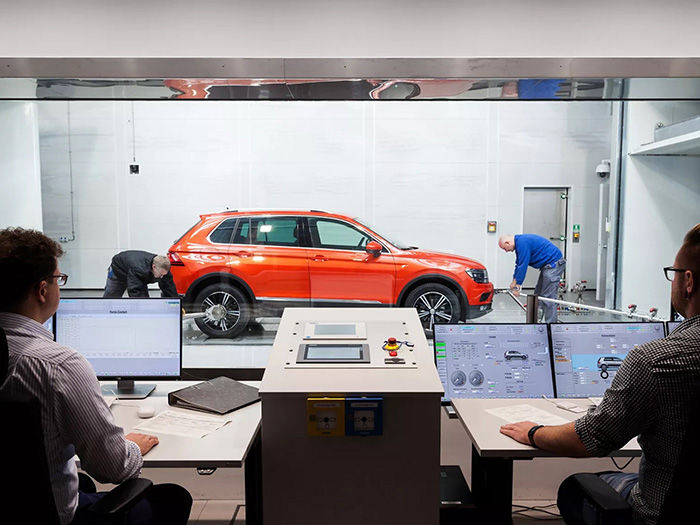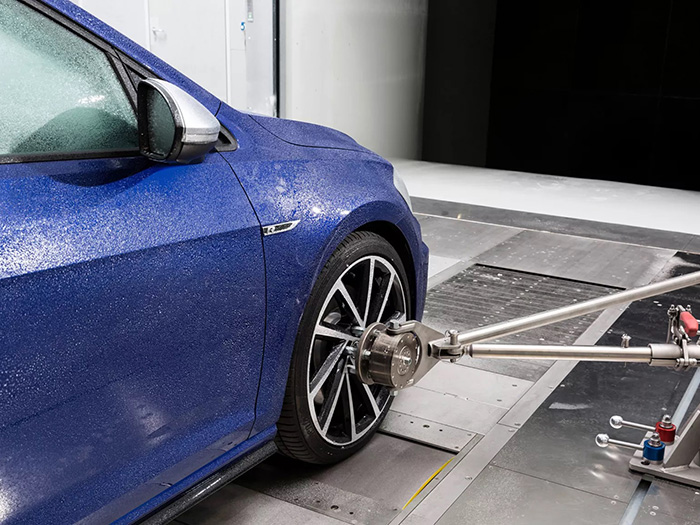Wind tunnel tests - efficiency in all conditions
Aerodynamics are fundamental for cars, determining both their efficiency and their range. The Wind Tunnel Efficiency Centre in Wolfsburg is where Volkswagen tests the ability of cars to slice through air - and not just that.
Among the elements that contribute to increasing efficiency levels in a car, aerodynamics play a key role. For this reason, the attention to details in this field is more and more important at the design stage.
The Wind Tunnel Efficiency Centre in Wolfsburg is one of the most advanced wind tunnels in the world and the tests conducted here make a significant contribution to the development of Volkswagen vehicles.
Simulation and reality

The wind tunnel in Wolfsburg comprises a huge tube at the end of which there is an imposing oversized turbine with metre-high rotor blades. When this starts moving, a high-tech storm is unleashed. Vehicles can then be tested in wind speeds of staggering speed - up to 250 kilometres per hour.
These tests are ever more important in the development of future vehicles, in particular when it comes to electric mobility where aerodynamics play a prominent role due to their decisive impact on the range. Particular attention was given to this aspect in the development of the ID.3 for example.
Silent blasts

Aerodynamics are crucial also for the other vehicles. The Wind Tunnel Efficiency Centre teams are working on more than 50 vehicle projects in order to reduce consumption rates, and increase efficiency and sustainability.
In the Aerodynamics Acoustics Tunnel the so-called “conveyor belt scales” ensure that real vehicle operations can be simulated, with each wheel standing on its own conveyor belt. The scales, with a built-in camera system, automatically adapt each model for the test in less than five minutes - prior to this technology, around 30 minutes were needed for this.
The tunnel’s acoustic insulation makes it one of the quietest automotive wind tunnels in the world. At 160 km/h wind speeds, it reaches a sound pressure level of only 65 decibels, similar to a television at normal volume.
Simulating the desert and the North Pole

But it isn’t just wind being generated for the development of better vehicles across the 8,800 square metres of the Wind Tunnel Efficiency Centre in Wolfsburg. Driving simulations for all globally occurring climatic and environmental conditions between minus 30 and plus 60 degrees Celsius are possible there, testing vehicles’ resistance and reliability.
In the Thermofunction Tunnel, every conceivable weather condition on earth can be simulated: sun, rain, snow – even rainforest conditions with 95% humidity can be generated.
Research determining the future

Volkswagen focuses entirely on vehicle development at the Wolfsburg location. Here, more than 10,000 employees work on the technology of the future. The Wind Tunnel Efficiency Centre is a further component for generating key impetus in efficiency, comfort and the quality of the cars that we will be driven over the next few years.
Another benefit of this advanced facility is a considerable reduction in the effort required for testing. Vehicles no longer have to be transported to distant countries and regions, which means savings in resources and a further contribution towards a positive CO2 balance. In addition, the cooperation between development areas such as vehicle safety, design, acoustics and comfort is considerably improved given that the teams work together in a central workshop area. Expertise and know-how is pooled, making design and development work even more effective.
Source: Volkswagen
